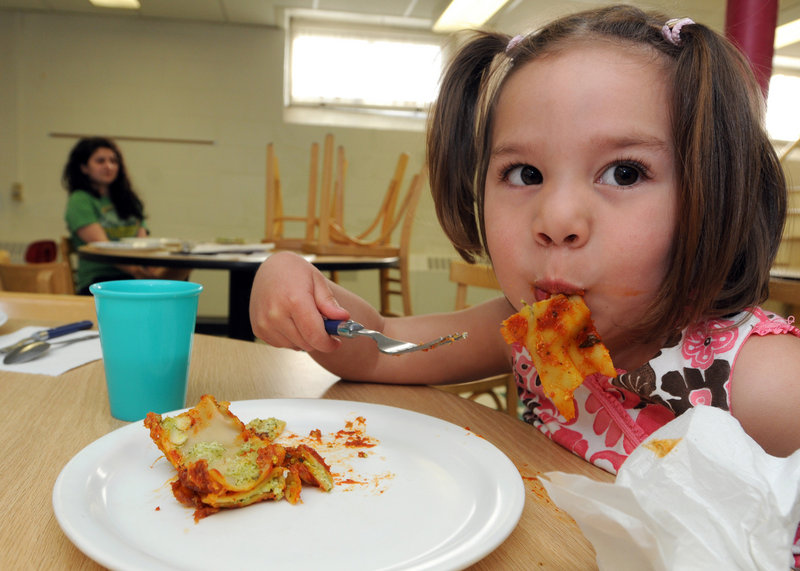BRATTLEBORO, Vt. – While the other preschoolers were warming up to the vegetable pesto lasagna, 3-year-old Avery Bennett dived in with no hesitation.
“Can I have some more lasagna?” Bennett said from her booster seat. “I love it.”
She moved on to her seconds, and the other kids at the evening care program in Brattleboro were also chomping down the dish made of spinach, peppers, carrots, tomato, fresh basil and cheese.
More low-income school kids could soon have access to free nutritious dinners like the lasagna that Avery loved. A U.S. Department of Agriculture program in Vermont, 12 other states and the District of Columbia provides reimbursements for the suppers, served at after-school programs for at-risk kids in communities where at least 50 percent of households fall below the poverty level.
“What it allows us to do is provide those kids with an extra nutritious meal before they go home because some kids go home to nothing,” said Susan Eckes, director of child nutrition programs for the Food Bank of Northern Nevada in McCarran, Nev.
Around the country, about 49,000 children benefit from the after-school meals each day. The program is expected to cost a total of $8 million from 2009 to 2013, the USDA said.
With more families losing jobs and homes, the need is growing, officials said.
The number of Americans who live in food-insecure households — which at times don’t have enough nutritious food — rose from 36 million people in 2007 to 49 million in 2008, according to the most recent report from USDA’s Economic Research Service.
Among those, 16.7 million were children, up from 12.4 million in 2007.
Nearly one in four children in the U.S. are food insecure and about one in five live in poverty, according to a report from Feeding America, a network of 200 food banks around the country.
“As the economy gets worse, we’re seeing more and more kids,” said Beth Baldwin-Page, executive director of the Boys & Girls Club of Brattleboro.
In East Prairie, Mo., kids who may have skipped the meal from time to time are coming every day, said Lester Gillespie, youth program director at the Susanna Wesley Family Learning Center, which serves 150 meals a day at two sites to kids age 5 to 18.
A lack of nutritious food, especially in the first three to five years, can have lasting effects on the health and development of children. Filling their stomachs with nutritional meals helps them learn and concentrate, officials have said.
“What we’ve noticed is that when kids are eating nutritional meals, they tend not to get involved in negative activities such as doing graffiti or committing delinquent acts … when their stomach is full they make good decisions,” said Gillespie.
Programs in Connecticut, Delaware, Illinois, Maryland, Michigan, Missouri, Nevada, New York, Oregon, Pennsylvania, West Virginia, Wisconsin, the District of Columbia and now in Vermont are eligible for reimbursement for suppers.
The USDA requires the sites to offer nutritionally balanced suppers with milk, a protein, fruit, vegetables and bread or a grain item.
Send questions/comments to the editors.



Success. Please wait for the page to reload. If the page does not reload within 5 seconds, please refresh the page.
Enter your email and password to access comments.
Hi, to comment on stories you must . This profile is in addition to your subscription and website login.
Already have a commenting profile? .
Invalid username/password.
Please check your email to confirm and complete your registration.
Only subscribers are eligible to post comments. Please subscribe or login first for digital access. Here’s why.
Use the form below to reset your password. When you've submitted your account email, we will send an email with a reset code.